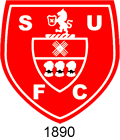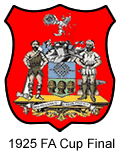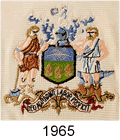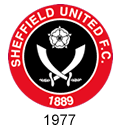Sheffield United
In 1855 Sheffield Cricket Club leased 8½ acres of land on the southern edge of the city from the Duke of Norfolk to provide open spaces free of the heavy pollution that accompanied the rapid expansion of the city's steel industry. At the time cricket was the recreation of choice but in 1862 the first recorded football match took place on the Bramall Lane site between Sheffield FC and Hallam FC. Five years later the Wednesday Cricket Club formed a football branch who played as Wednesday FC (later Sheffield Wednesday) for several years at Bramall Lane before they moved away to build their own ground.
In March 1889 Bramall Lane hosted the English FA Cup semi-final between Preston North End and West Bromwich Albion. The match attracted so much interest that within a week a public meeting was organised when it was resolved to form a professional football club linked to the Sheffield United Cricket Club. Indeed, Sheffield United continued to share Bramall Lane with the county cricket club until 1973.
 Sheffield United played their first match in August 1889 and joined the Northern League. In those days the team usually wore white shirts but for the 1890-91 season they turned out in red and white "butcher's stripes." A crest appeared in the 1891-92 season that consisted of the badge of the city of Sheffield, a chevron with three sheaves of wheat, apparently a typical heraldic play on words, Shef-field being interpreted as "the open space by the River Sheaf."
Sheffield United played their first match in August 1889 and joined the Northern League. In those days the team usually wore white shirts but for the 1890-91 season they turned out in red and white "butcher's stripes." A crest appeared in the 1891-92 season that consisted of the badge of the city of Sheffield, a chevron with three sheaves of wheat, apparently a typical heraldic play on words, Shef-field being interpreted as "the open space by the River Sheaf."
In 1892 the Football League was extended with the addition of a Second Division. United’s application to join the Football League (which would become the First Division) was rejected but they were invited to join the Second Division instead. United, who now adopted their signature two-inch red and white striped shirts, won promotion at the first attempt via the test matches and would remain in the First Division until 1934.
In 1898 “The Blades” (Sheffield was famous for producing high quality steel cutlery) won the First Division championship for the first, and so far only time. The following year they won the FA Cup with the legendary William “Fatty” Foulke in goal. In 1901 they lost to Southern League Tottenham in the final but had their revenge in 1902 when they won the cup for the second time, beating Southampton. Their third FA Cup success came in 1915, this time Chelsea were beaten in the final.
success came in 1915, this time Chelsea were beaten in the final.
After the First World War United won the FA Cup for the fourth time in 1925. The crest worn in this match was, as was customary, the city's coat of arms. Interestingly United did not wear a crest in any of the other cup finals they appeared in.
In 1934 the Blades were relegated to the Second Division. In 1936, while still in Division Two they reached another FA Cup Final but lost to Arsenal. In 1939 they returned to the top flight only for war to interrupt their progress.
 For thirty years after the resumption of League football in 1946, Sheffield United moved between the top two divisions no fewer than seven times, their longest spell at the top being between 1961 and 1968. The Sheffield coat of arms appeared in 1965 and remained until 1977. For the 1967-68 season, the team wore white shorts for the first time. As the season ended in relegation this experiment was quickly dropped, although white shorts have been worn more recently.
For thirty years after the resumption of League football in 1946, Sheffield United moved between the top two divisions no fewer than seven times, their longest spell at the top being between 1961 and 1968. The Sheffield coat of arms appeared in 1965 and remained until 1977. For the 1967-68 season, the team wore white shorts for the first time. As the season ended in relegation this experiment was quickly dropped, although white shorts have been worn more recently.
In 1973, after a long argument, the football club finally decided that playing both cricket and football on the same ground was no longer viable and a new 7400 capacity stand was built on the open fourth side of the ground, opening in 1975 after the club’s most successful season for years when they finished sixth in Division One.
Football is, of course, a fickle business. No sooner was the new stand open than United went into a steep decline that saw them relegated to Division Two in 1976 and then, after a missed penalty in the last minute of the last match of the 1980-81 season, the Blades found themselves in Division Four. Cynics may point out that this dramatic fall from grace coincided with the first of many ill-conceived redesigns of the club’s cherished red and white striped shirts.
cherished red and white striped shirts.
While opinion may be divided about the shirts worn in this period there is no question that the new crest introduced in 1977 was a design classic. The club's nickname, "The Blades" was represented by crossed scimitars was surmounted by a Yorkshire rose. Variations appeared: between 1981 and 1992 it was rendered in outline only while from 1992 until 1999 it was placed on shields of varying shape but the fundamental design remained unchanged.
The revival was not long in coming. In 1982 United were Fourth Division champions at the first time of asking and two years later they were back in Division Two. Relegation in 1988 was the prelude to a remarkable change in fortune that brought successive promotions and a place in Division One. In 1994, however, the club were relegated from the Premiership. After regularly challenging for promotion, The Blades were promoted back to the top flight in 2006 but relegated to the Championship in 2007 and then, in 2011, League One.
In the first deal of its kind in England, United and Wednesday shared the same sponsors in 2011-12. United wore the logo of Westfield Health Insurance Company on their home shirts and that of a Volkswagen dealership on their away shirts while Wednesday reversed the arrangement. This followed concern expressed by local businesses that by sponsoring one club and not the other some supporters would be alienated from their brand. Similar concerns had led to Celtic and Rangers sharing sponsorship since 1999.
